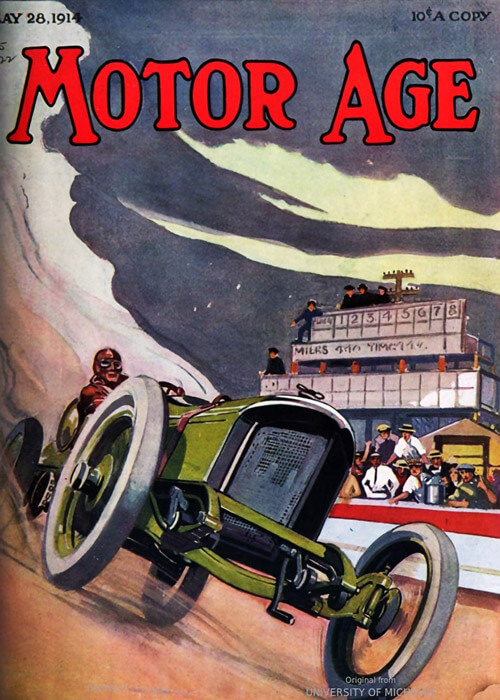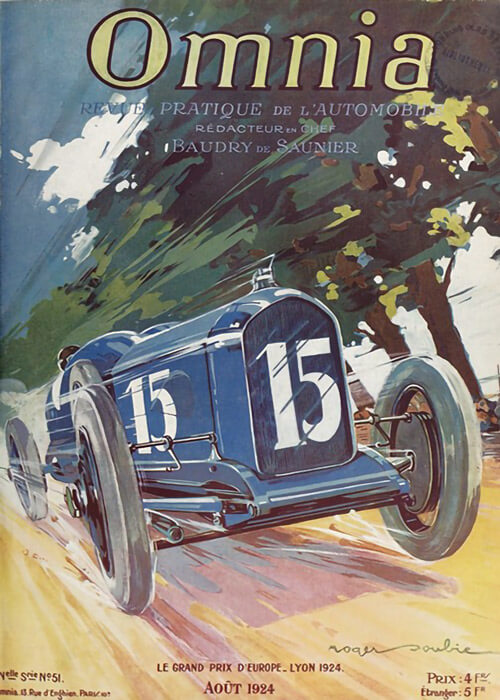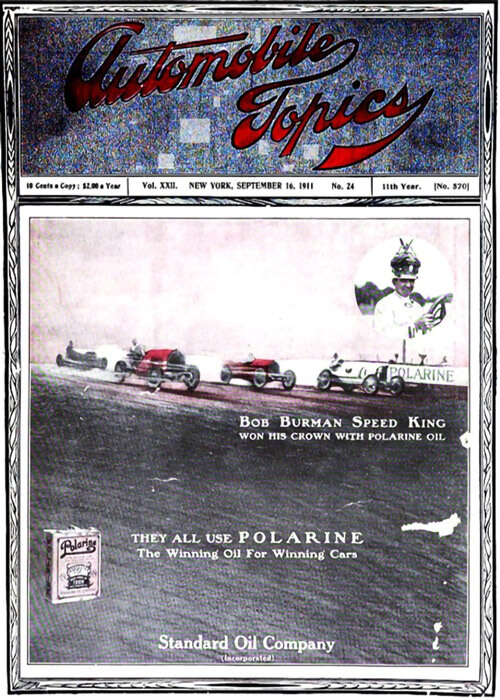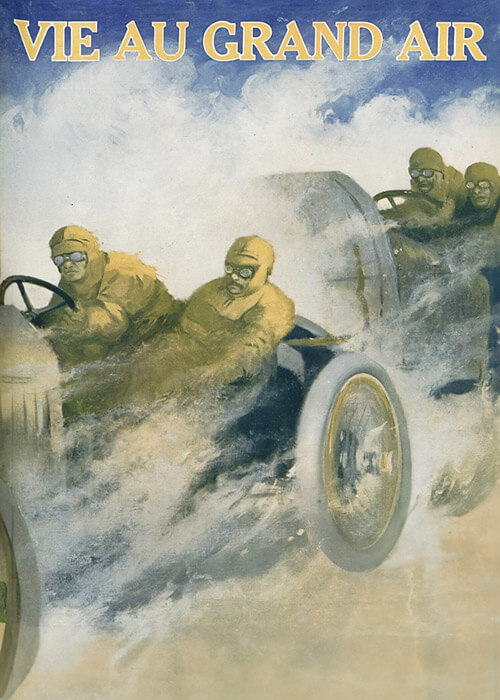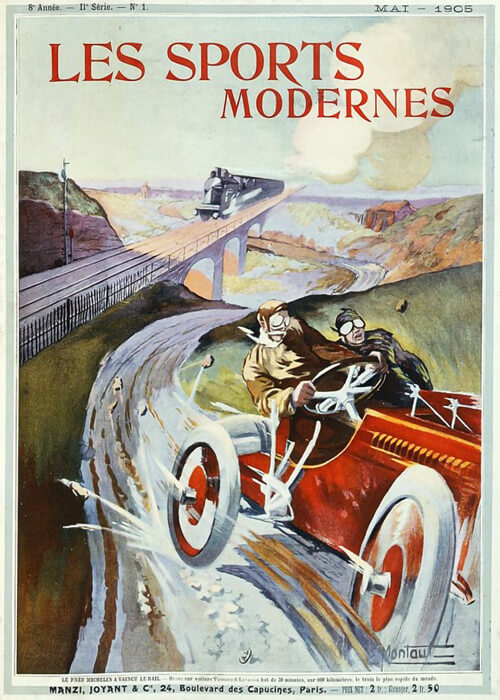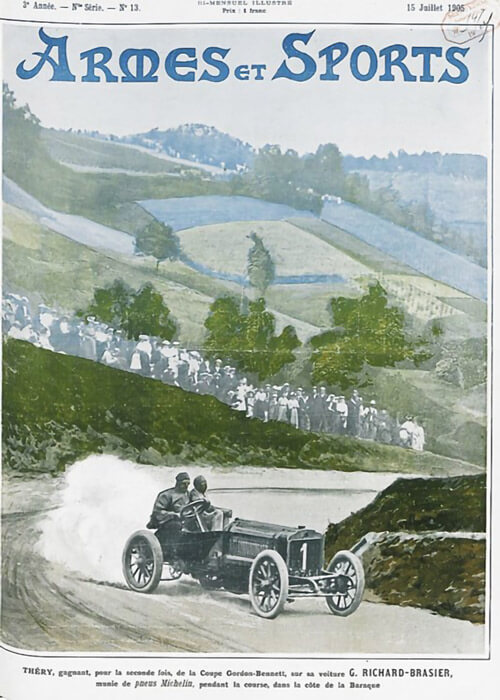In May 25, July 1911, just a week before the start of the first ever Indianapolis 500-mile race, some issues were published on the preparations, the starting field to date and the prizes to win.

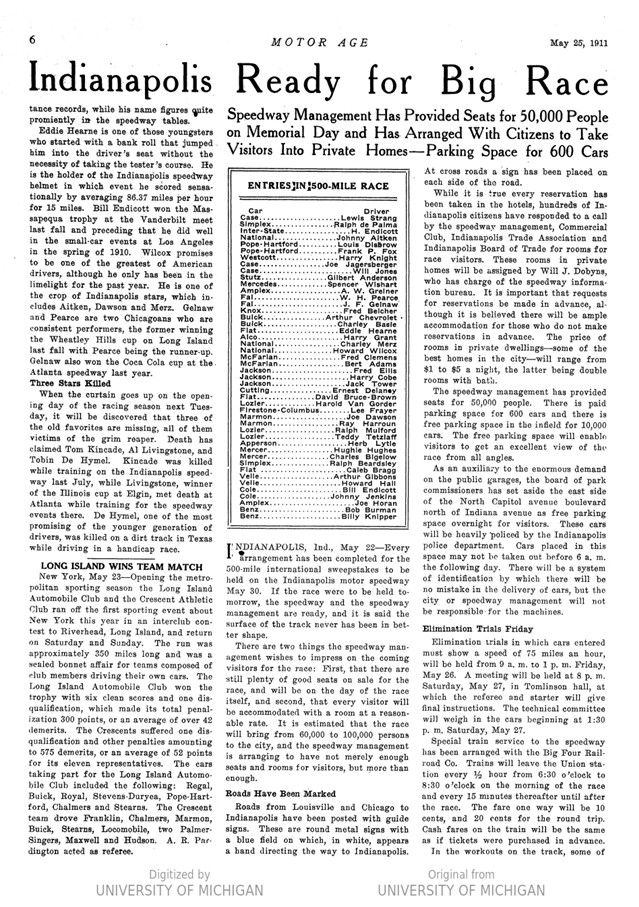
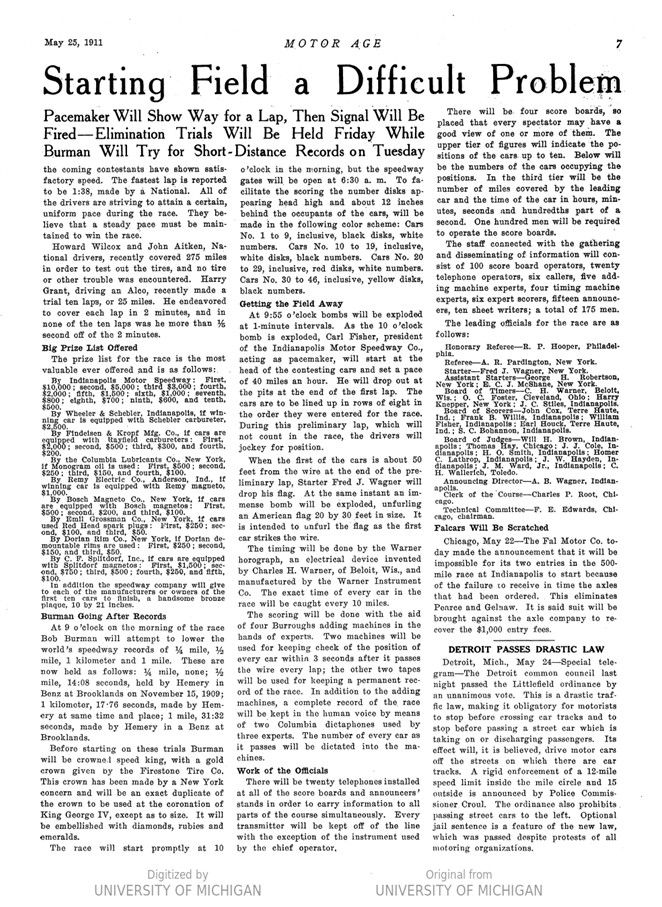
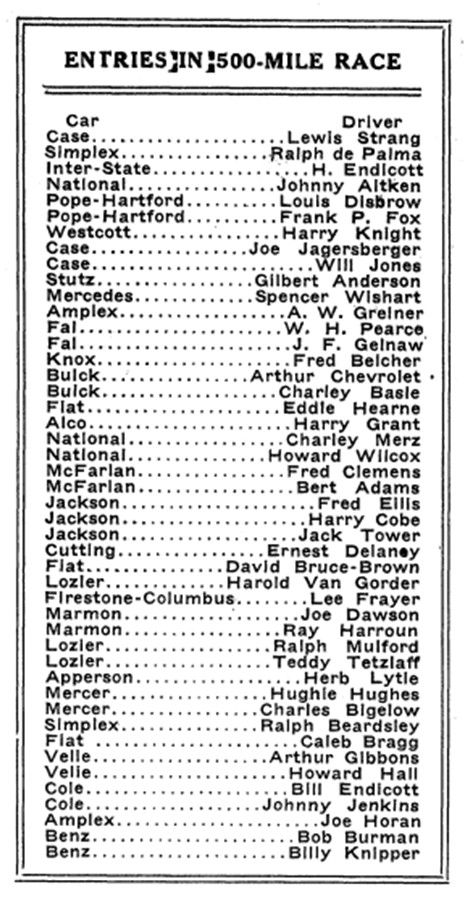
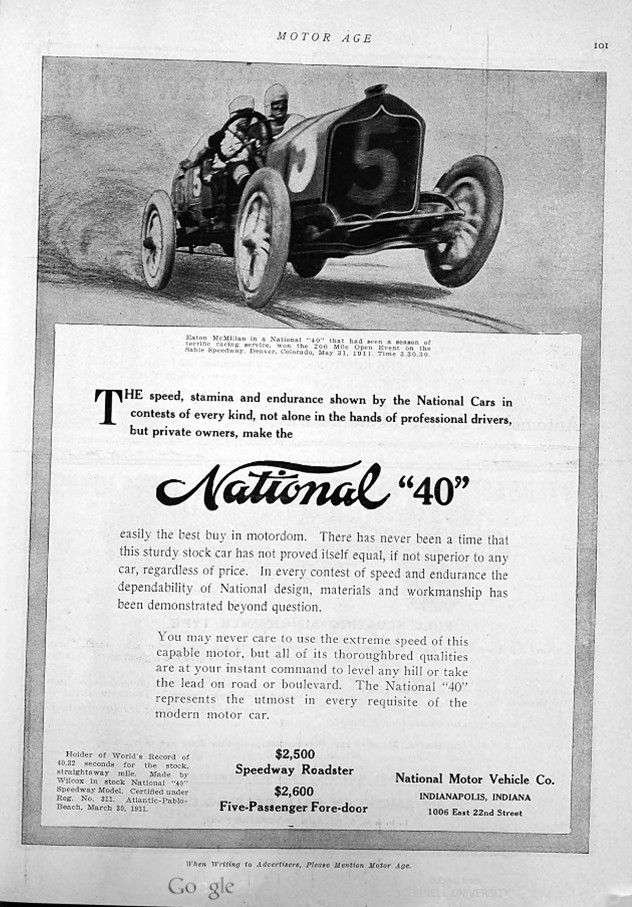
Text and jpegs by courtesy of hathitrust.org www.hathitrust.org, compiled by motorracinghistory.com
Motor Age, Vol. XIX, No. 21, May 25, 1911
Indianapolis Ready for Big Race – Starting Field a Difficult Problem
Speedway Management Has Provided Seats for 50,000 People on Memorial Day
Has Arranged With Citizens to Take Visitors Into Private Homes
Parking Space for 600 Cars
Pacemaker Will Show Way for a Lap, Then Signal Will Be Fired
Elimination Trials Will Be Held Friday While Burman Will Try for Short-Distance Records on Tuesday
INDIANAPOLIS, Ind., May 22 — Every arrangement has been completed for the 500-mile international sweepstakes to be held on the Indianapolis motor speedway May 30. If the race were to be held tomorrow, the speedway and the speedway management are ready, and it is said the surface of the track never has been in better shape.
There are two things the speedway management wishes to impress on the coming visitors for the race: First, that there are still plenty of good seats on sale for the race, and will be on the day of the race itself, and second, that every visitor will be accommodated with a room at a reasonable rate. It is estimated that the race will bring from 60,000 to 100,000 persons to the city, and the speedway management is arranging to have not merely enough seats and rooms for visitors, but more than enough.
Roads Have Been Marked
Roads from Louisville and Chicago to Indianapolis have been posted with guide signs. These are round metal signs with a blue field on which, in white, appears a hand directing the way to Indianapolis. At cross roads a sign has been placed on each side of the road.
While it is true every reservation has been taken in the hotels, hundreds of Indianapolis citizens have responded to a call by the speedway management, Commercial Club, Indianapolis Trade Association and Indianapolis Board of Trade for rooms for race visitors. These rooms in private homes will be assigned by Will J. Dobyns, who has charge of the speedway information bureau. It is important that requests for reservations be made in advance, although it is believed there will be ample accommodation for those who do not make reservations in advance. The price of rooms in private dwellings — some of the best homes in the city — will range from $1 to $5 a night, the latter being double rooms with bath.
The speedway management has provided seats for 50,000 people. There is paid parking space for 600 cars and there is free parking space in the infield for 10,000 cars. The free parking space will enable visitors to get an excellent view of the race from all angles.
As an auxiliary to the enormous demand on the public garages, the board of park commissioners has set aside the east side of the North Capitol avenue boulevard north of Indiana avenue as free parking space overnight for visitors. These cars will be heavily policed by the Indianapolis police department. Cars placed in this space may not be taken out before 6 a. m. the following day. There will be a system of identification by which there will be no mistake in the delivery of cars, but the city or speedway management will not be responsible for the machines.
Elimination Trials Friday
Elimination trials in which cars entered must show a speed of 75 miles an hour, will be held from 9 a.m. to 1 p. m. Triday, May 26. A meeting will be held at 8 p.m. Saturday, May 27, in Tomlinson hall, at which the referee and starter will give final instructions. The technical committee will weigh in the cars beginning at 1:30 p. m. Saturday, May 27.
Special train service to the speedway has been arranged with the Big Four Railroad Co. Trains will leave the Union station every / hour from 6:30 o’clock to 8:30 o’clock on the morning of the race and every 15 minutes thereafter until after the race. The fare one way will be 10 cents, and 20 cents for the round trip. Cash fares on the train will be the same as if tickets were purchased in advance. In the workouts on the track, some of the coming contestants have shown satisfactory speed. The fastest lap is reported to be 1:38, made by a National. All of the drivers are striving to attain a certain, uniform pace during the race. They believe that a steady pace must be maintained to win the race.
Howard Wilcox and John Aitken, National drivers, recently covered 275 miles in order to test out the tires, and no tire or other trouble was encountered. Harry Grant, driving an Alco, recently made a trial ten laps, or 25 miles. He endeavored to cover each lap in 2 minutes, and in none of the ten laps was he more than 1/5 second off of the 2 minutes.
Big Prize List Offered
The prize list for the race is the most valuable ever offered and is as follows:
By Indianapolls Motor Speedway : First, $10,000; second, $5,000; third $3,000; fourth, $2,660, fifth, $1,500; sixth, $1,000; seventh, $800; eighth, $700; ninth, $600, and tenth, $500.
By Wheeler & Schebler, Indianapolis, if winning car is equipped with Schebler carbureter, $2,500.
By Findeisen & Kropf Mfg. Co., if cars are equipped with Rayfield carbureters : First, § ; second, $500; third, $300, and fourth,
By the Columbia Lubricants Co., New York, if Monogram oil is used : First, $500; second, $250; third, $150 and fourth $160.
By Remy Electric Co., Anderson, Ind., if winning car is equipped with Remy magneto, $1,000.
By Bosch Magneto Co., New York, if cars are equipped with Bosch , magnetos: First, $500; second, $200, and third, $100.
By Emil Grossman Co., New York, if cars used Red Head spark plugs : First, $250 ; second, $100, and third, $50.
By Dorian Rim Co., New York, if Dorian demountable rims are used : First, $250 ; second, 150, and third, $50.
By C. F. Splitdorf, Inc., if cars are equipped with Splitdorf magnetos : First, $1,500 ; second, $750; third, $500; fourth, $250, and fifth, 100.
In addition the speedway company will give to each of the manufacturers or Owners of the first ten cars to finish, a handsome bronze plaque, 10 by 21 inches.
Burman Going After Records
At 9 o’clock on the morning of the race Bob Burman will attempt to lower the world’s speedway records of 34 mile, 4% mile, 1 kilometer and 1 mile. These are now held as follows: 34 mile, none; }; mile, 14:08 seconds, held by Hemery in Benz at Brooklands on November 15, 1909; 1 kilometer, 17:76 seconds, made by Hemery at same time and place; 1 mile, 31:32 seconds, made by Hemery in a Benz at Brooklands.
Before starting on these trials Burman will be crowned speed king, with a gold crown given by the Firestone Tire Co. This crown has been made by a New York concern and will be an exact duplicate of the crown to be used at the coronation of King George IV, except as to size. It will be embellished with diamonds, rubies and emeralds.
The race will start promptly at 10 o’clock in the morning, but the speedway gates will be open at 6:30 a. m. To facilitate the scoring the number disks appearing head high and about 12 inches behind the occupants of the cars, will be made in the following color scheme: Cars No. 1 to 9, inclusive, black disks, white numbers. Cars No. 10 to 19, inclusive, white disks, black numbers. Cars No. 20 to 29, inclusive, red disks, white numbers. Cars No. 30 to 46, inclusive, yellow disks, black numbers.
Getting the Field Away
At 9:55 o’clock bombs will be exploded at 1-minute intervals. As the 10 o’clock bomb is exploded, Carl Fisher, president of the Indianapolis Motor Speedway Co., acting as pacemaker, will start at the head of the contesting cars and set a pace of 40 miles an hour. He will drop out at the pits at the end of the first lap. The cars are to be lined up in rows of eight in the order they were entered for the race. During this preliminary lap, which will not count in the race, the drivers will jockey for position.
When the first of the cars is about 50 feet from the wire at the end of the preliminary lap, Starter Fred J. Wagner will drop his flag. At the same instant an immense bomb will be exploded, unfurling an American flag 20 by 30 feet in size. It is intended to unfurl the flag as the first car strikes the wire.
The timing will be done by the Warner horograph, an electrical device invented by Charles H. Warner, of Beloit, Wis., and manufactured by the Warner Instrument Co. The exact time of every car in the race will be caught every 10 miles.
The scoring will be done with the aid of four Burroughs adding machines in the hands of experts. Two machines will be used for keeping check of the position of every car within 3 seconds after it passes the wire every lap; the other two tapes will be used for keeping a permanent record of the race. In addition to the adding machines, a complete record of the race will be kept in the human voice by means of two Columbia dictaphones used by three experts. The number of every car as it passes will be dictated into the machines.
Work of the Officials
There will be twenty telephones installed at all of the score boards and announcers’ stands in order to carry information to all parts of the course simultaneously. Every transmitter will be kept off of the line with the exception of the instrument used by the chief operator.
There will be four score boards, so placed that every spectator may have a good view of one or more of them. The upper tier of figures will indicate the positions of the cars up to ten. Below will be the numbers of the cars occupying the positions. In the third tier will be the number of miles covered by the leading car and the time of the car in hours, minutes, seconds and hundredths part of a second. One hundred men will be required to operate the score boards.
The staff connected with the gathering and disseminating of information will consist of 100 score board operators, twenty telephone operators, six callers, five adding machine experts, four timing machine experts, six expert scorers, fifteen announcers, ten sheet writers; a total of 175 men. The leading officials for the race are as follows:
Honorary Referee—R. P. Hooper, Philadelphia.
Referee.—A. R. Pardington, New York.
Starter–Fred J. Wagner, New York.
Assistant Starters—George B. Robertson, New York; E. C. J. McShane, New York.
Board of Timers—C. H. Warner, Beloit, Wis.; O. C. Foster, Cleveland, Ohio ; Harry Rnepper, New York ; J. C. Stiles, Indianapolis.
Board of Scorers—John Cox, Terre Haute, Ind. ; Frank B. Willis, Indianapolls; William Fisher, Indianapolis ; Earl Houck, Terre Haute, Ind. ; Ś. C. Bohannon, Indianapolis.
Board of Judges—Will H. Brown, Indianapolis ; Thomas Hay Chicago ; J. J. Cole, Indianapolis; H. O. Smith, Indianapolis; Homer C. Lathrop, Indianapolis ; J. W. , Hayden, In- dianapolis; J. M. ard, Jr., Indianapolis; C. H. Wallerich, Toledo.
Announcing Director—A. B. Wagner, Indianapolis.
Clerk of the Course—Charles P. Root, Chicago.
Technical Committee—F. E. Edwards, Chicago, chairman.
